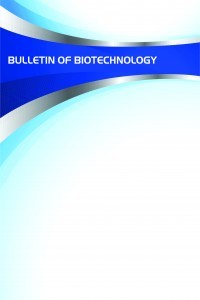Hatice Banu KESKİNKAYA, Cengiz AKKÖZ, Erdoğan GÜNEŞ, Malak ABBAS FADHIL, Emine Şükran OKUDAN, Serdar KARAKURT
Determination of antimicrobial activity of different extracts of Enteromorpha intestinalis (Linnaeus Nees.1820) against pathogenic microorganisms
Determination of antimicrobial activity of different extracts of Enteromorpha intestinalis (Linnaeus Nees.1820) against pathogenic microorganisms
It is known that components such as polyphenols, flavonoids and polysaccharides have antimicrobial activity in macroalgae in aquatic environments. In this study, it was aimed to determine the antimicrobial activities of E.intestinalis (L.) Nees methanol, 70% ethanol and water extracts against different pathogenic microorganisms, which are economically important marine macroalgae. According to Broth Microdilution Method; Antimicrobial activities of different extracts of the studied species against Escherichia coli, Pseudomonas aeruginosa, Klebsiella pneumoniae, Staphylococcus aureus, Salmonella enteritidis, Sarcina lutea and Bacillus cereus standard bacterial strains and Candida albicans fungus strain were evaluated by determining the Minimum Inhibition Concentration (MIC).According to the findings, it was observed that the water extract of the studied species showed no antimicrobial activity against any test organism. The methanol extract of E.intestinalis was found to have antimicrobial activity against Pseudomonas aeruginosa, Staphylococcus aureus, Sarcina lutea ,Bacillus cereus and Candida albicans strain, while ethanol extract was observed against Pseudomonas aeruginosa ,Sarcina lutea and Candida albicans strains. The highest antibacterial effect was observed in E.intestinalis (L.) Nees methanol extract and the most effective strain was Bacillus cereus (0.390 mg/ml). Nowadays, algae are of great importance in terms of being very useful drug raw material, containing the basic components, being more effective and less toxic, as well as being models for drugs with original drug-like physiological activity. Since the data obtained with this study are intended for prospective application, it is thought that alternative drug applications will be provided as a basis for the studies aimed at reducing the use of commonly used antibiotic and antifungal agents against pathogenic microorganisms.
___
- Abbasoğlu, U, Tosun F, Aydınoğlu A (1995). Antimicrobial activity of Gonocytisus angulus (L.) Spach. FABAD, Journal of Pharmaceutical Sciences, 20:125-127.
- Akköz C, Arslan D ,Ünver A, Özcan, MM, Yılmaz B (2011) Chemıcal Composıtıon, Total Phenolıc And Mıneralcontents Of Enteromorpha Intestınalıs (L.) Kütz. And Cladophora Glomerata (L.) Kütz. Seaweeds. Journal of Food Biochemistry, 35 : 513–523.
- Baris O, Gulluce M, Sahin F, Ozer H, Kilic H, Ozkan H, Sokmen M, Ozbek T (2006) Biological activities of the essential oil and methanol extract of Achillea biebersteinii Afan. (Asteraceae), Turk. J. Biol., 30:65-73.
- Buruk CK, (2002) Doğu karadeniz bölgesi’nde yetişen bazı endemik bitkilerin antimikrobiyal etkilerinin araştırılması, Doktora Tezi, Karadeniz Teknik Üniversitesi, Sağlık Bilimleri Enstitüsü, Trabzon.
- Grierson, DS, Afolayan AJ (1999) Antibacterial activity of some indigenous plants used for the treatment of wounds in the Eastern Cape, South Africa. J. Ethnopharmacol., 66:103-106.
- Gupta S, Cox S, Rajauria G, Jaiswal AK, Abu-Ghannam N (2012) Growth inhibition of common food spoilage and pathogenic microorganisms in the presence of brown seaweed extracts. Food and Bioprocess Technology, 5(5): 1907-1916. Kaufman PB, Wu W, Kim D, Cseke LJ, (1995) Handbook of molecular and cellular methods in biology and medicine, CRC Press Inc., Corporate Blvd.,N.W., Boca Raton, Florida, vol 33 pp 431-438.
- Lourens ACU, Reddy D, Baser KHC, Viljoen AM, Van Vuuren SF (2004). In vitro biological activity and essential oil composition of four indigenous South African Helichrysum species, J. Ethnopharmacol., 9:253-258.
- Mendoza MT (1998) What’s new in antimicrobial susceptibility testing? Philipp. J. Microbiol. Infect. Dis., 27(3): 113-115.
- Mansuya P, Aruna P, Sridhar S, Kumar JS, Babu S (2010) Antibacterial activity and qualitative phytochemical analysis of selected seaweeds from Gulf of Mannar region. Journal of Experimental Sciences, 1(8): 23-26.
- Nostro A, Germano MP, D’Angelo V, Marino A, Cannatelli MA (2000) Extraction methods and bioautography for evaluation of medicinal plant antimicrobial activity. Lett. Microbiol., 30(1): 379-384.
- Salie F, Eagles PFK, Lens HMJ (1996) Preliminary antimicrobial screening of four South African Asteraceae species. J. Ethnopharmacol., 52(1): 27-33.
- Rauha J, Remes S, Heinonen M, Hopia A, Kahkönen M, Kujala T, Pihlaja K, Vuorela H, Vuorela P (2000) Antimicrobial effects of Finnish plant extracts containing flaconoids and other phenolic compounds. Intern. J. Food Microbiol. 56: 3-12.
- Varier KM, Milton, MCJ., Arulvasu, C, Gajendran B (2013) Evaluation of antibacterial properties of selected red seaweeds from Rameshwaram, Tamil Nadu, India. Journal of Academia and Industrial Research, 1(11): 667-670.
- Yoldaş MA., Katırcıoğlu H, Beyatlı Y (2003) Bazı Mavi-Yeşil Alglerin (Cyanophyta- Cyanobacteria) Poli-β-hidroksibütirat (PHB) Üretimi ve Antimikrobiyal Aktivitelerinin İncelenmesi. E.Ü. Su Ürünleri Dergisi 20: 467-471.
- Zbakh H, Chiheb H, Bouziane H, Sánchez VM, Riadi H (2012) Antibacterial activity of benthic marine algae extracts from the Mediterranean coast of Morocco. Journal of Microbiology, Biotechnology and Food Sciences, 2(1): 219-228.
- Yayın Aralığı: Yılda 2 Sayı
- Başlangıç: 2020
- Yayıncı: Avrasya Araştırma Geliştirme Bilim ve Teknoloji Merkezi Limited Şirketi
